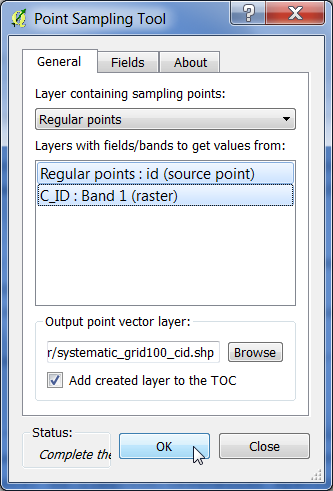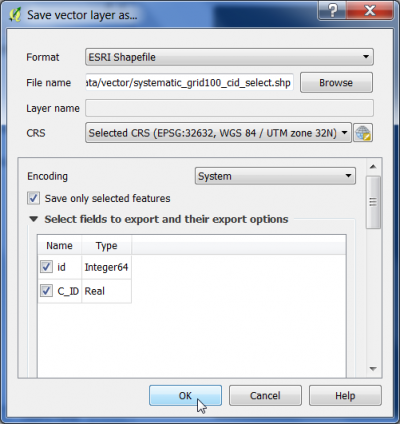Point sampling on raster
From AWF-Wiki
(Difference between revisions)
(→Second phase: stratified sampling with equal allocation) |
(→Second phase: stratified sampling with equal allocation) |
||
| (8 intermediate revisions by one user not shown) | |||
| Line 1: | Line 1: | ||
| − | = First phase systematic sampling = | + | = First phase: systematic sampling = |
# Click {{mitem|text=Plugins --> Manage and Install Plugins}}. | # Click {{mitem|text=Plugins --> Manage and Install Plugins}}. | ||
# Type in the search bar {{typed|text=Point sampling tool}}, click on the plugin name and then on {{button|text=Install plugin}}. | # Type in the search bar {{typed|text=Point sampling tool}}, click on the plugin name and then on {{button|text=Install plugin}}. | ||
| − | # Load the single band raster file ''C_ID.tif'' created by [Convert vector to | + | # Load the single band raster file ''C_ID.tif'' created by [[Convert vector to raster]]. |
| − | # Load the regular grid as vector point file ''systematic_grid100.shp''' created by [ | + | # Load the regular grid as vector point file ''systematic_grid100.shp''' created by [[Creating regular grid]]. |
| − | # Make sure that both layers are ticked in the [TOC]. | + | # Make sure that both layers are ticked in the [[TOC]]. |
# Open the '''Point Sampling Tool''' clicking [[File:Qgis_psample_button.png]]. | # Open the '''Point Sampling Tool''' clicking [[File:Qgis_psample_button.png]]. | ||
# Select the layer containing sampling points. | # Select the layer containing sampling points. | ||
| − | # Specify the output of the resulting vector file marking column with ''' | + | # Specify the output of the resulting vector file marking column with '''CTRL + left click'''. |
# Enter an output shapefile name ''systematic_grid100_cid.shp'' and path by clicking {{button|text=Browse}}. | # Enter an output shapefile name ''systematic_grid100_cid.shp'' and path by clicking {{button|text=Browse}}. | ||
# Confirm with {{button|text=OK}}. The new layer is added to the Layer Panel . | # Confirm with {{button|text=OK}}. The new layer is added to the Layer Panel . | ||
[[File:Qgis_point_sample.png|400px]] | [[File:Qgis_point_sample.png|400px]] | ||
| − | = Second phase: stratified sampling with equal allocation = | + | = Second phase: stratified random sampling with equal allocation = |
* In the search engine of the Processing Toolbox, type Random selection and select '''Random selection within subsets''' under Vector selection tools of QGIS. | * In the search engine of the Processing Toolbox, type Random selection and select '''Random selection within subsets''' under Vector selection tools of QGIS. | ||
| − | * Select | + | * Select the regular point grid (result of [[Creating regular grid]]) as the input layer. |
* Select the Column name containing the grouping class code as ID field. | * Select the Column name containing the grouping class code as ID field. | ||
* Enter 10 as sample size for each category. | * Enter 10 as sample size for each category. | ||
| − | * Click | + | * Click {{button|text=Run}} to execute the algorithm. |
| − | + | * Mark the the regular point grid in the [[TOC]]. Right click, {{button|text=Save as...}}. | |
| + | * Format of the output vector file is '''ESRI Shapefile''' | ||
| + | * Do not forget to tick '''Save only selected features'''. | ||
| + | * Define directory and output file name. | ||
| + | * Click {{button|text=Run}} to save the file. | ||
| + | [[File:Qgis_vector_saveas2.png|400px]] | ||
[[category:Working with Vector Data]] | [[category:Working with Vector Data]] | ||
Latest revision as of 17:22, 27 November 2017
[edit] First phase: systematic sampling
- Click Plugins --> Manage and Install Plugins.
- Type in the search bar Point sampling tool, click on the plugin name and then on Install plugin.
- Load the single band raster file C_ID.tif created by Convert vector to raster.
- Load the regular grid as vector point file systematic_grid100.shp' created by Creating regular grid.
- Make sure that both layers are ticked in the TOC.
- Open the Point Sampling Tool clicking
 .
.
- Select the layer containing sampling points.
- Specify the output of the resulting vector file marking column with CTRL + left click.
- Enter an output shapefile name systematic_grid100_cid.shp and path by clicking Browse.
- Confirm with OK. The new layer is added to the Layer Panel .
[edit] Second phase: stratified random sampling with equal allocation
- In the search engine of the Processing Toolbox, type Random selection and select Random selection within subsets under Vector selection tools of QGIS.
- Select the regular point grid (result of Creating regular grid) as the input layer.
- Select the Column name containing the grouping class code as ID field.
- Enter 10 as sample size for each category.
- Click Run to execute the algorithm.
- Mark the the regular point grid in the TOC. Right click, Save as....
- Format of the output vector file is ESRI Shapefile
- Do not forget to tick Save only selected features.
- Define directory and output file name.
- Click Run to save the file.

